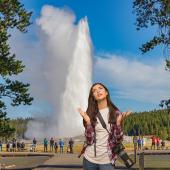Tips From the Lens of Oz
Bozeman's Stan Osolinski (aka “The Lens of Oz”) has learned a few things about nature photography after 40 years of capturing images in the field. Take, for instance, a possible shot of a bird in a tree. When he frames that shot, he notices a line leading to the bird from a tree branch. That juxtaposition makes the image more than the bird. “It tells a story about how the bird lives, what it eats,” says Osolinski. Osolinski's images have been showcased internationally, and he is a past winner of the prestigious BBC Wildlife Photographer of the Year award in bird photography.
He says, “I think the reason I love photography so much is that it combines art and science so that the whole is greater than the sum of its parts.” That last idea is the difference between taking a picture and composing one, according to Osolinski. It's a matter of sensing what is most compelling in a particular scene. “I’m just a spectator. Mother Nature is the artist,” he notes.
Just the same, he says, “Photography is nothing compared with reality. When you sit down to lunch, you don’t want to do that with a photograph of a friend in the chair across from you. You want their company. It’s the same with nature.”
Here are ten of Stan's best tips.
1. Get up for first light.
2. It doesn’t matter who you are or how good you are. If you aren’t there, you won’t see it.
3. Great images happen in unusual circumstances, in adverse weather, in exceptional light.
4. Learn to use the best filter there is: earth’s atmosphere.
5. Pay attention to composition. Watch how colors go together. See how lines lead the eye.
6. Look with both a physical and a psychological sight.
7. Remember, a technically perfect image can generate no response.
8. Don’t interfere with wildlife. Know about the animal you will be photographing and keep as far away as you can from “big critters,” giving them and yourself some safety. Big lenses help.
9. Watch and wait. See. A favorite quote of Stan’s goes something like, “It doesn’t matter how far you go, but how close you look.”
10. If you see it, take it. Don’t count on it being there tomorrow. It won’t be.
Jenna Caplette is a former staff member of F-11 Photo in Bozeman. She navigates the learning curve of the craft of photography in part by writing about it.











